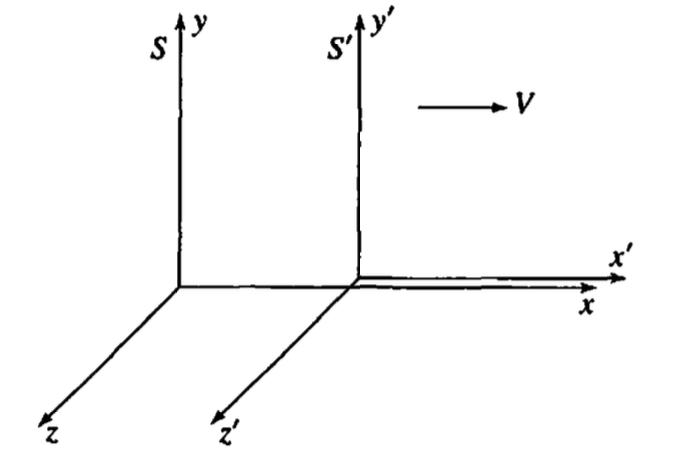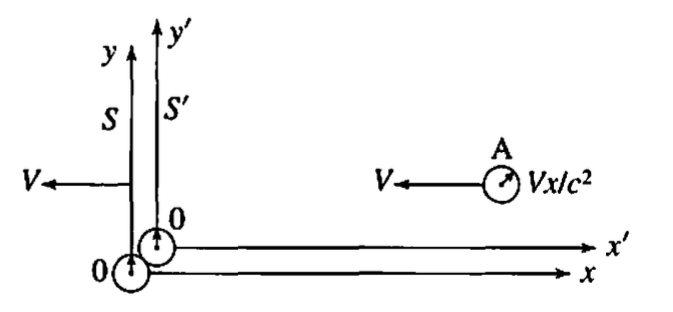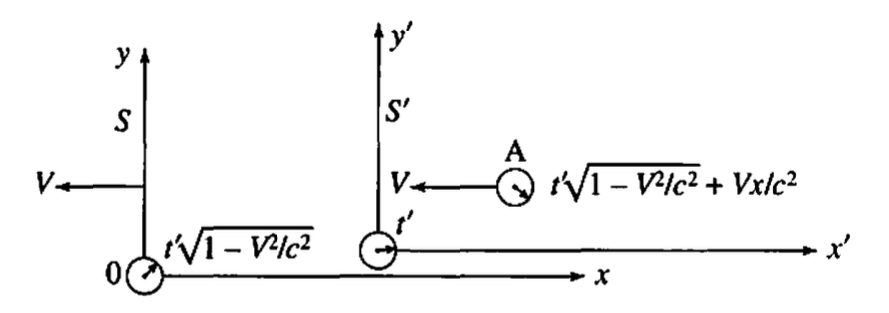To transform events between reference frames, we use the Lorentz Transformation.
The Need for a Better Transformation
- imagine the two reference frames below

- according to Galilean Transformation
- this transform is flawed
- length and time are frame-independent (can’t be true as seen in Intro to Special Relativity)
- velocity transformation is light speed is different in different frames (also not true)
- need a robust transformation compatible with length contraction, time dilation, and velocity
Lorentz Transformation
- sync clocks in both frames to when origins coincide
- then event occurs at
- in
- in
Coordinate Transformation
- in terms of :
- origins are offset by
- observer in sees contracted by
- that means
- since no velocity in directions,
Time Transformation
- to get new time transformation (), we will
- set up a clock at rest at in frame
- and observe it from .
- also place two clocks at origins of and that are synced to when origins coincide
- clock at origin of lags clock by according to simultaneity
- diagram shown below

- after passes in ,

- has moved to the left
- clock at origin of runs slow because of time dilation, so reads
- same for clock , plus leading clock lag, so clock reads
- solving for ,
Summary
- substituting (helps with calculations) and
- by definition in Significance
- we get
Notice this is just a linear transformation:
\begin{pmatrix} x' \\ ct' \end{pmatrix} = \begin{pmatrix} \gamma & - \beta\gamma \\ -\beta\gamma & \gamma \end{pmatrix}\begin{pmatrix} x \\ ct \end{pmatrix} .$$ ## Verifying Time Dilation, Length Contraction, and Simultaneity - observe a person moving at $v=\beta c$ for a time $t$ - applying the transformation to get their time:\begin{align} ct’&=\gamma ct-\beta\gamma x \ &= \gamma ct-\beta\gamma(\beta ct) \ &= \gamma(1-\beta^{2})ct \ \implies t’ &= \frac{t}{\gamma}. \end{align}
- now if the person is horizontal with head at $x_{1}'$ and feet at $x_{2}'$ in their frame and - in our frame, we observe their head at $x_{1}$ and feet at $x_{2}$ when synchronized clocks at $x_{1}$ and $x_{2}$ read $t$, - the length of the person in their rest frame isD = x_{1}’ - x_{2}’ = \gamma(x_{1}-Vt) - \gamma(x_{2}-Vt) = \gamma(x_{1}-x_{2})
x_{1} - x_{2} = \frac{D}{\gamma}
- we can verify simultaneity holds by checking if leading clock lags in both frames - put clock at person's head ($x_{1}'$) and feet ($x_{2}'$) in their rest frame (prime frame) - then, the lag between the two clocks ist_{1}‘-t_{2}’
t_{1}‘-t_{2}’ = \frac{(t_{1}-t_{2}) - (V / c^{2})(x_{1}-x_{2})}{\sqrt{ 1-V^{2} / c^{2} }}
- if measurement in our frame is simultaneous ($t_{1}=t_{2}$), thent_{1}‘-t_{2}’ = - \left( \frac{V}{c^{2}} \right) \frac{x_{1}-x_{2}}{\sqrt{ 1-V^{2} / c^{2} }} = -\frac{V}{c^{2}}(x_{1}‘-x_{2}’) = -\frac{V}{c^{2}}D
## Velocity Transformation - now observe the same person, but we move at velocity $V$ - calculating the velocity of the object in our new frame,\begin{align} \frac{dx’}{dt’}&=\frac{dx’}{dt}\left( \frac{dt}{dt’} \right) \ &= \frac{dx’ / dt}{dt’ / dt} \ \end{align}
- plugging in $x' = \gamma(x-Vt)$, $t' = \gamma(t- \frac{Vx}{c^{2}})$, we get\begin{align} \frac{dx’}{dt} &= \gamma\left( \frac{dx}{dt}-V \right) \ \frac{dt’}{dt} &= \gamma\left( 1-\left( \frac{V}{c^{2}} \right) \frac{dx}{dt}\right) \ \frac{dx’}{dt’} &= \frac{\gamma(dx / dt - V)}{\gamma(1-(V / c^{2})dx / dt)} \ v_{x}’ &= \frac{v_{x}-V}{1-Vv_{x}/ c^{2}} \end{align}
- for other dimension $y,z$ - person still only moves in $x$\begin{align} \frac{dy’}{dt’} &=\frac{dy’ / dt}{dt’ / dt} \ &= \frac{dy / dt}{\gamma(1-(V / c^{2})dx / dt)} \ v’{y} &= \frac{v{y}\sqrt{ 1-V^{2} / c^{2} }}{1-Vv_{x} / c^{2}} \end{align}
### Faster than the Speed of Light? - now imagine two spaceships moving towards each other at $0.99c$ and $-0.99c$ - velocity greater than $c$?! - no lol - if we (static observer of event) boost to $0.99c$ - $V=0.99c$ - $v_{x}=-0.99c$\begin{align} v_{x}’ &= \frac{-0.99c - 0.99c}{1-\frac{(0.99)(-0.99)c^{2}}{c^{2}}} \ &= -\frac{1.98c}{1.9801} \ &= -0.99995c \end{align}